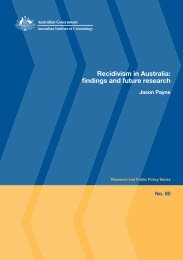Tracking violent crime - Australian Institute of Criminology
Tracking violent crime - Australian Institute of Criminology
Tracking violent crime - Australian Institute of Criminology
You also want an ePaper? Increase the reach of your titles
YUMPU automatically turns print PDFs into web optimized ePapers that Google loves.
constant in his <strong>of</strong>fences, although aspects <strong>of</strong> the signature may evolve as he progresses<br />
from <strong>crime</strong> to <strong>crime</strong>. An example <strong>of</strong> a signature aspect may be the particular way that<br />
the <strong>of</strong>fender binds his victim, or the order <strong>of</strong> his sexual acts. Unless an analyst is<br />
trained to recognise the significance <strong>of</strong> these acts, vital information connecting the<br />
<strong>of</strong>fences may be lost.<br />
The cornerstone <strong>of</strong> effective analysis and case linkage, is standardised data collection<br />
methodology and entry. The ViCLAS data collection forms contain simple, closed<br />
ended questions and “formatted“ multiple choice answers. The adoption <strong>of</strong> this<br />
methodology overcomes a variety <strong>of</strong> common data collection errors that occur with<br />
narrative based systems.<br />
As Canada is a bilingual country the system was developed so that it crosses language<br />
difficulties. Each standardised answer to the ViCLAS questions has been assigned a<br />
value and when the analyst queries the system, it is actually the value assigned to the<br />
answer given, rather than the language used, that the computer searches on. So the<br />
language <strong>of</strong> data entry is irrelevant for all queries involving formatted fields. This will<br />
<strong>of</strong> course not function in areas that narrative text appears. However, given the<br />
comprehensive nature <strong>of</strong> the data collection forms and the corresponding formatted<br />
fields, text searches should be rare, and if required, the system still has that capability.<br />
Confidentiality is an important issue. The actual data entered is still owned by the<br />
agency who is responsible for investigating the <strong>of</strong>fence. There are strict privacy<br />
conditions placed on who can view the data, and if a linkage is identified then the<br />
investigators are advised <strong>of</strong> that but not <strong>of</strong> the specific details <strong>of</strong> the linked case. It is<br />
then up to the discretion <strong>of</strong> each investigator as to what is shared.<br />
PROBLEMS AND SOLUTIONS FOR AUSTRALIAN LAW ENFORCEMENT<br />
Australia has not escaped the serial murder or the serial rape phenomena. The media<br />
reports in avid detail the <strong>crime</strong>s <strong>of</strong> each <strong>of</strong> them. We can all recall people like John<br />
Glover, the New South Wales Granny murderer - who killed 6 elderly women, and<br />
Ivan Milat, convicted <strong>of</strong> the murders <strong>of</strong> the seven backpackers in the Belanglo State<br />
Forest environs.<br />
The serial killer and rapist differ from other <strong>of</strong>fenders as he <strong>of</strong>ten plans his <strong>crime</strong>s,<br />
selects a certain type <strong>of</strong> victim and a location, is confident, monitors his own<br />
behaviour to avoid detection and as there is <strong>of</strong>ten no relationship between himself and<br />
the victim, he is difficult to detect.<br />
Problems identified by law enforcement in not only investigating these <strong>crime</strong>s, but<br />
also in linking these <strong>crime</strong>s include:<br />
1. Mobility <strong>of</strong> the Offender<br />
6















